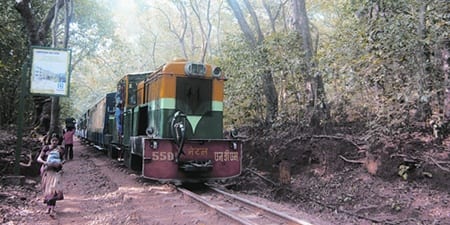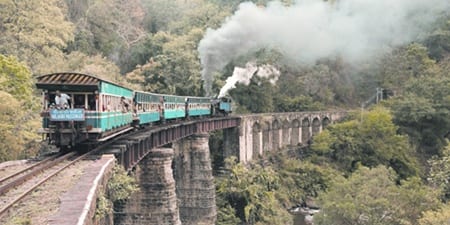Mountain railways: Picture-perfect journeys
The mountain railways of India is a unique heritage tourism experience which is popular with both international and domestic crowd. Better packaging and marketing can further enhance these rail journeys as a global tourism product
The mountain railways of India are an integral part of the country’s rich legacy. The most famous are the UNESCO World Heritage Sites of Darjeeling Himalayan Railway, Kalka-Shimla Railway and Nilgiri Mountain Railway. Other heritage railways completing the list are Kangra Valley railway and hill section (Lumding-Halflong-Badarpur) of the Northeast Frontier Railway.
Darjeeling’s pride
Darjeeling Himalayan Railway is a fine example of a rail transportation system, situated at a height of 2,067 metres. Started in 1881, this ‘toy train’ takes off from New Jalpaiguri, going up 88 km to Darjeeling and passing through dense forest on hill slopes, reverses and loops – among the most famous being Batasia, that provides a glimpse of Mount Kanchenjunga. The section has eight major bridges, 542 minor bridges and 177 unmanned crossings.
Partha Guha, general secretary, Eastern Himalayas Travel and Tour Operators’ Association (EHTTOA) says, “This train is popular with both international as well as domestic tourists who are keen to experience the journey. The last two – three years there were landslides because of which the entire route has not been opened. For the last three years part of the route was closed, after the monsoons the route will be reopened in the month of October before the start of the festive season and we are hoping that the big journey will start.” In Darjeeling even if a tourist stays for a night, the joy ride is a compulsory inclusion in the itinerary.
The whole journey takes eight to nine hours. According to Guha, most tourists do not want to take the entire route, they are interested in the joy ride which starts from Darjeeling and goes to Batasia route which is very popular. There are two types of trains for the joy ride, one is heritage steam engine and the other is diesel engine. “The steam engine is more than 100 years old, for which it has got the World Heritage status. The diesel engines are not that popular, they are fast and powerful but lack the heritage feeling. The problem is that the steam engines are old and the diesel ones are not popular. The heritage trains rates are Rs 1300 while for diesel it is about Rs 850. It is difficult to get tickets for the hertiage train,” adds Guha.
There are four rides every day. The joy ride is mostly part of the package. “In the morning after the trip to Tiger Hill, tourists have their breakfast and then they go for a joy ride. It is part of the main itinerary now, previously it was not that popular and people used to go on their own,” states Guha, affirming that it has a great potential as a tourism product.
Legacy of the Raj
Kalka-Shimla Railways dates back to the pre-Independence era and was opened to public in 1903. The six-hour journey takes travellers through many picturesque stations like Dharampur and Taksa, tunnels and many arched bridges as well as offering views of the Himalayan snow-capped peaks.
The journey starts from Kalka railway station and it takes about five – six hours to reach Shimla. Major stations are at Dharampur, Barog, Solan, Kanda Ghat and Summer Hill. People take only one way journey on this train. Ankur Sodhi, owner of Pine Valley Holidays, Shimla who exclusively provides travel packages for Himachal Pradesh says, “We get emails from all over the world and get about 10 calls daily for booking of Kalka-Shimla toy train. As a tour operator our main problem is that there is no option for Tatkal booking. We always recommend tourists to do their bookings from IRCTC website. Alternately, we also book their trains from Indian Railways here in Shimla. There are only five trains every day, during summer vacations there are also holiday special trains.” Pointing out that these trains are overbooked, Sodhi adds, that apart from the issue of Tatkal booking which handicaps the tour operators, the journey offers a lot to the tourists in terms of the scenic route.
Another world heritage site is the Nilgiri Mountain railways nestled amidst the Nilgiri hills in Tamil Nadu. Opened in 1899 from Mettupalalyam to Coonoor and later extended to Ooty in 1908, the main attraction of this line are its unique tracks and complicated steam locomotives. It passes through 16 tunnels, forest-clad mountains and tea plantations.
While Matheran Light Railways was opened to public in 1907, the Kangra Valley railway in Himachal Pradesh opened to traffic in 1929. It is famous for its bridges, a total of 933, and at 1,289 metres, its highest station at Ajhu offers a view of the Himalayas.
The mountain railways have been marked as protected areas of natural, environmental and cultural value. These heritage parks have to be harnessed with innovative social and technological ideas that encourage visitors to bond with the local community, thus demanding that the area be protected and conserved for sustainable development.



